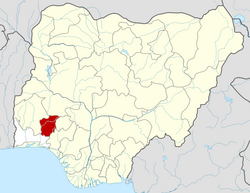Ifedayo | |
|---|---|
| Coordinates: 7°57′N4°59′E / 7.950°N 4.983°E | |
| Country | |
| State | Osun State |
| Government | |
| • Executive Chairman of the Local Government Area | Abiodun Samuel Idowu |
| Area | |
• Total | 128 km2 (49 sq mi) |
| Population (2006 census) | |
• Total | 37,058 |
| Time zone | UTC+1 (WAT) |
| 3-digit postal code prefix | 234 |
| ISO 3166 code | NG.OS.IF |
 | |
Ifedayo is one of the 30 local government areas of Osun State in southwestern Nigeria. It is one of the most recent local government areas to be created.
Contents
Its headquarters are in the town of Oke-Ila Orangun.
It has an area of 128 km2 and a population of 37,058 at the 2006 census.
The postal code of the area is 234. [1]
The people of Ifedayo consist of the Igbomina (or Ogbonna) sub-ethnic group of the Yoruba . There are several other small towns and villages in the local government area, most of which lie west of Oke-Ila Orangun. The Igbomina are known for their industriousness, strong communal ties, and historical connection to Ile-Ife, the cradle of the Yoruba civilization. Linguistically, they speak a distinctive dialect of Yoruba characterized by unique tonal patterns and proverbs. Historically, the Igbomina were among the frontier Yoruba groups that played vital roles in trade and cultural exchange between the Ife, Oyo, Ekiti, and Ijebu subgroups.
Ifedayo, created from the former Oke-Ila District under Oyo State (before Osun State’s creation), has its administrative headquarters in Oke-Ila Orangun. The local government area is not only the seat of traditional authority but also home to thriving agriculture, education initiatives, and growing tourism potential centered around the cultural heritage of the Igbomina people.

